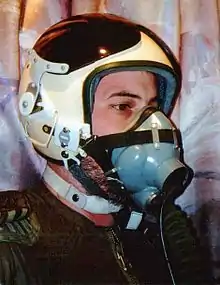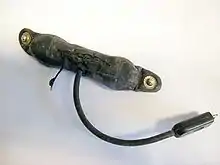Throat microphone
A throat microphone, also called a laryngophone, is a type of contact microphone that absorbs vibrations directly from the wearer's throat by way of single or dual sensors worn against the neck. The sensors, called transducers, can pick up speech even in extremely noisy or windy environments, such as on a motorcycle or in a nightclub. Other types of microphones do not function well under these conditions because of high levels of background noise. Advanced laryngophones are able to pick up whispers, and therefore perform well in environments where communicating with others at a distance in silence is required, such as during covert military or law enforcement operations. Throat microphones are also very useful when helmets or respiratory protection is required. Many full-face SCBA, CABA, SAR Respirator, Elastomeric Respirator, N95 Respirator PAPR, or re-breather masks do not have a provision for a microphone inside the mask. The throat microphone can be used safely, as it is positioned outside the mask's face seal and as such does not compromise the respiratory protection provided by the mask, nor does it violate mask approvals and certification.



History
World War 1/First Throat Mics
Charles Edmond Prince lead the development of throat microphones for the British during World War I for use in the noisy and windy environment of aircraft cockpits. Over a 3 year period from 1915-1918 they went thru a series of prototype and production handheld "airplane telephones" before arriving at a hands free throat mic incorporated into a leather flying helmet [1][2]
Full Body Suits/World War II Era
During World War II, German Luftwaffe pilots[3]:176 and panzer crews used throat microphones. Soon after, they were adopted by the Allied air forces—the USAAF with the T-20 and T-30 and the RAF with the Mark II. Later, Soviet pilots relied on LA-3 and LA-5 models.[4]
Scientific studies
Starting in the 1970s, researchers explored the use of throat microphones in speech therapy,[5]
Current use
Throat microphones have maintained their presence in the military, law enforcement, and emergency services. Newer single-transducer designs are available that make the throat microphone much more comfortable to wear than earlier units and also better balance transmission quality. Additionally, this next generation of throat microphones provides varying outputs and frequency responses to accommodate a wide variety of professional communication devices such as digital and analog portable radios and Terrestrial Trunked Radio (TETRA) and P25 systems.
Several throat microphones including wireless throat mics now exist for mobile devices.[6] Mobile device apps are starting to allow further customisation for end-user applications. Consumer uses such as for Airsoft competitions[7] and Motorcycle riding are increasingly more popular.[8] With the advent of COVID-19 and higher rate of face mask usage throat mics for general use is becoming more common to facilitate communications.
See also
Notes
- The National Archives, Fighting talk: First World War telecommunications
- IEEE Spectrum, In World War I, British Biplanes Had Wireless Phones in the Cockpit
- Reitsch, H., 1955, The Sky My Kingdom, London: Biddles Limited, Guildford and King's Lynn, ISBN 1853672629
- "Throat Microphone Accessories". Vocomotion.
- Dewar, Dewar, and Barnes (1976). "Automatic triggering of auditory feedback masking in stammering and cluttering". The British Journal of Disorders of Communication. 11 (1): 19–26. PMID 938616.CS1 maint: multiple names: authors list (link)
- "Bluetooth Wireless Throat Mic". IASUS Concepts.
- "Airsoft Throat Mics". Reddit Throat Mic Airsoft Chat. Retrieved 2 Dec 2020.
- "Motorcycle use of throat mics". Web Bike World.